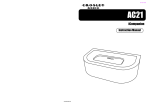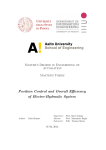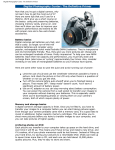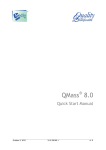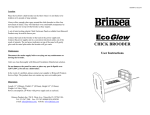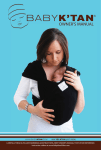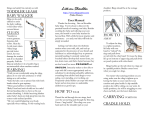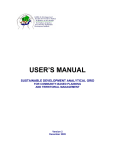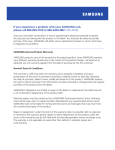Download Inside Look - Sleep Diagnosis and Therapy
Transcript
Sleep_3_7.qxd 11/10/08 7:04 PM Page 18 Inside Look BRAEBON Medical Corporation Launches the MediByte Junior, a New Type 3 Device for Home Sleep Testing Don C. Bradley, Chief Technology Officer and Richard A. Bonato, Ph.D., President and CEO of BRAEBON Medical Corporation discuss their new MediByte® Junior 6-Channel Type 3 Home Sleep Testing Device. What led you to develop the MediByte Junior? Richard Bonato: We felt that there was a need in the marketplace for an entry-level home sleep testing recorder. Specifically, in light of both the recent CMS rulings regarding the approval of CPAP reimbursement based on home sleep testing, and the new guidelines published by the American Academy of Sleep Medicine. We identified a definite need in the marketplace for an entry-level Type 4 plus-one-channel device, which would be upgradeable to an entry-level Type 3 device. What we ended up doing was taking a look at our MediByte technology platform which has been on the market for 2 years, and we decided to create an entry-level Type 4 device, which is upgradeable to a Type 3 device by simply purchasing the optional RIP effort belt as an upgrade. The technology is extremely affordable and complies with the portable monitoring guidelines of the American Academy of Sleep Medicine. The MediByte Junior is shipped in a case about the size of a shaving kit and is easily upgraded to a Type 3 device by replacing the Velcro band with a respiratory inductive plethysomnography (RIP) effort sensor. By upgrading the technology, the user is able to bill the MediByte Junior as a Type 3 device. The MediByte Junior offers the advantage to start with the simplicity of a Type 4 device and the option to upgrade to a Type 3 device if desired. Explain any features that make the MediByte Junior unique? Don Bradley: The prime feature of the MediByte Junior is the unique ability of having a very small, extremely easy-to-use, upgradeable device that can actually work with a CPAP device while at the same time offering RIP technology. The MediByte Junior offers SpO2, pulse, airflow, body position and RIP all built into one unit. With these features, the device can be used both to diagnose sleep apnea as well as monitor the effectiveness of treatment. The MediByte Junior can record CPAP pressures, airflow and snoring as well as the option of offering RIP technology to monitor respiratory effort. The MediByte Junior remains the smallest, most reliable Type 3 device on the market. The ease of use for the clinician as well as the patient makes the MediByte Junior the best cutting-edge technology that meets CMS requirements for Type 3 and Type 4 reimbursements. The “event button” feature and the user-friendly software make the device extremely easy to work with. The use of pictures aids in set-up of the device and helps to reduce errors. Many users have been able to use the device without ever opening the user manual and users have been impressed with the ease of use. Braebon has built in other features to ensure exceptional data quality while at the same time minimizing 18 the chance of data loss during the study. Some of these features include connectors that lock when pushed in so that they do not inadvertently disconnect during the study. Another feature that ensures less errors and loss of data is that no two connectors are alike which means the patient or clinician cannot plug the wrong sensor into the wrong port. The device also offers a feature so that it starts recording automatically or it can be started in manual mode. The MediByte Junior can record for two consecutive nights. All the technology in the MediByte Junior improves the likelihood the clinician using this device will be able to record high quality, reliable data. Another important feature of the MediByte Junior Don Bradley: During the design phase of the MediByte Junior, we concentrated on the concept of being easy to use. In this context, we wanted to minimize headaches for both the end user and the patient. One of the key features considered was power and the decision not to use a rechargeable battery, which will often not be charged when it is needed most. Because a quick turn-around is often needed when preparing for a home sleep test, the user will often not have the time to wait for a battery to charge. The MediByte Junior, is ready to use in a matter of minutes. Data can be downloaded and the device can be turned around for re-use within ten minutes without having to spend valuable time for a recharge. Supplying the patient with a fresh battery significantly reduces the likelihood of data collection failure. The Braebon MediByte Junior addresses all the headaches regarding battery power, including locking the battery compartment so that the patient is unable to disturb the device's power. All of these added features make the MediByte Junior unique among Type 3 and 4 home testing Sleep Diagnosis and Therapy ♦ Vol 3 No 7 November-December 2008 Sleep_3_7.qxd 11/10/08 7:04 PM Page 19 devices. The ergonomic appeal and small size makes the MediByte Junior a first-class device that consistently ensures high quality data collection. How will the MediByte Junior benefit users? Richard Bonato: The MediByte Junior is extremely userfriendly. The software guides the user through initializing the device and it automatically downloads the data at the end of the night. The software offers an “assisted scoring” feature. After the data is downloaded, the clinician reviews and edits the data for final analysis. The device comes with an easy-toread user manual and offers laminated patient guides so that the patient can easily understand how to connect the sensors to the device. Braebon also offers a comprehensive patient instructional MediByte video in DVD format. The video is very important because the LCDs now permit patient instructional videos prior to home sleep testing. The MediByte Junior is beneficial to physicians, technologists and end-users because it is affordable and upgradeable with an unparalleled price point and combination of ease-of-use. It provides the opportunity for many more clinicians to test an additional patient population that previously have not been tested. This group includes those who are reluctant to go to a sleep disorders laboratory for a variety of reasons. The MediByte Junior extends the diagnostic arm an additional six inches into the community. This device will definitely benefit communitybased medicine and extends the traditional laboratory reach into the community. How would it benefit patients? Don Bradley: The greatest benefit to patients is the size of the MediByte Junior and the fact that it provides limited interference with the patient's sleeping habits. For example, if the patient wants to get up in the middle of the night, move around, or snuggle with their bed partner, there will be no trouble with doing that. The physician is also able to obtain data that is a true reflection of the patient's normal sleep. Since all the sensors lock in place, there is no worry regarding loss of data or the patient having to worry about reattaching sensors during the night. The small size of the MediByte Junior allows the patient to sleep as normal as possible without the need to have a large cumbersome piece of equipment in the bedroom. There are only 2 sensors that attach from the device which makes it a lot easier for the patient to hook themselves up which increases the chance of obtaining error-free data. Several studies have shown that 90% of the population with sleep apnea has never been diagnosed, mainly because of costs and inconvenience. The MediByte Junior offers sleep centers a greater opportunity to test this patient population. The most important purpose that the MediByte Junior serves is providing a reliable resource for data collection and analysis in the home environment while allowing the sleep centers a much faster turn-around in getting these patients treated. How do you think the MediByte Junior is going to impact portable sleep monitoring? Don Bradley: Braebon believes that the MediByte Junior will have a profound impact on the use of portable monitoring and sleep disorders medicine, particularly because the technology is offered at a reasonable price while at the same time providing an entry-level screening tool for clinicians to reach a larger patient population. The device will also benefit patients by providing physicians an efficient and accurate technology to quickly screen and treat sleep apnea. The MediByte Junior will have a profound impact as a new benchmark for portable home sleep testing. Since the MediByte Junior is upgradeable from Type 4 to Type 3 and can be used in combination with its bigger sibling, the complete MediByte kit, it provides a combined price point which is actually less than single recorders from other companies. What is the main difference between the MediByte and the new MediByte Junior? Richard Bonato: The original MediByte is the sophisticated, complete Type 3 product with all the bells and whistles to exceed the new scoring guidelines. It is a 12-channel recorder which is aimed at sleep laboratories that want to meet and/or exceed the American Academy of Sleep Medicine guidelines for complete Type 3 home sleep testing. The MediByte is extremely powerful and suitable for dental sleep medicine and those dentists interested in TMD or temporal mandibular joint pain, for ENT physicians interested in snoring and for Cardiologists because it can record ECG for up to 24 hours. The full laboratory system MediByte really targets clinicians interested in more than entry-level screening. The MediByte Junior on the other hand, is a 6-channel recorder and is upgradeable from a Type 4 screener to Type 3 device by simply adding a RIP belt. It has a unique entry-level target in the marketplace aimed at enabling physicians and clinicians to meet the CMS requirements for Type 4 and Type 3 home sleep testing devices. MediByte ® is a registered trademark of BRAEBON Medical Corporation. Sleep Diagnosis and Therapy ♦ Vol 3 No 7 November-December 2008 19







